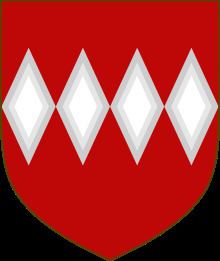Noble family D'Aubigny Mother Sybil Valoignes | Father Ralph d'Aubigny Buried Jerusalem Parents Sybil Valoignes | |
 | ||
Coat of arms Gules, four fusils conjoined in fess argent Died 1236, Kingdom of Jerusalem | ||
Philip d'Aubigny, sometimes Phillip or Phillipe Daubeney (c.a. 1166 – c.a. 1236), a knight and royal chancellor, was one of 5 sons of Ralph d'Aubigny and Sybil Valoignes, whose ancestral home was Saint Aubin-d'Aubigné in Brittany. He was lord of the manor of Chewton Mendip, South Petherton, Bampton, Waltham and Ingleby and Keeper of the Channel Islands.
Contents
Life and career
Following his fathers death, Philip's elder brother, Ralph, inherited estates at Belvoir, Ingleby, Saxilby and Broadholme. Ralph, however, later defected to the French in 1205. Philip and at least two of his brothers entered the service of Robert de Breteuil, earl of Leicester, and was granted the manor of Waltham.
Philip, unlike his elder brother, remained loyal to John and was appointed the keeper of the Channel Islands that same year. Philip was present at the signing of the Magna Carta as a member of the king's party, and was mentioned within the document. He participated in First Barons War and was leader of the royalist forces in Kent and Sussex. He partook in the Battle of Lincoln in 1217, and commanded a ship during the Battle of Sandwich later that same year.
Following the Pro-Angevin victory in the war he was made the tutor of the young Henry III. For his role in the king's education, d'Aubigny was granted the manors of Chewton Mendip and South Petherton in Somerset, and Bampton in Oxfordshire. In July 1228 he was granted 500 marks by the king to join Emperor Frederick II's crusade, however he most likely did not go as he was a royal emissary at the time. At some point between 1232 and 1234, regained the Channel Islands and played a prominent part in negotiations between the king and Pierre, Duke of Brittany.
In 1235, d'Aubigny set out on crusade with his brother Oliver, however died in the Holy Land a year later, and was subsequently buried in front of the Church of the Holy Sepulchral Jerusalem. As Philip left no legitimate children, his estate in South Petherton and a majority of his Lincolnshire lands were granted to his nephew, Ralph d'Aubigny, the brother of Philip the younger.
Family
Philip d'Aubigny was the son of Ralph d'Aubigny and Sybil Valoignes, and grandson of William d'Aubigny. He was of brother of Oliver d'Aubigny, Alice d'Aubigny, John d'Aubigny, Gunnora de Gaunt, William De Stuteville, Matilda d'Aubigney, Ralph d'Aubigny and Elias d'Aubeny
Oliver d'Aubigny married the widow of the leading royalist Philip of Oldcoates in 1221, and later bequeathed land at Enderby in Leicestershire upon his death to the canons of Croxton Abbey, where he was buried.
Philip d'Aubigny was the cousin of William d'Albigny, one of the twenty-five executors of the Magna Carta in 1215.
The d'Aubigny lands of Ingleby and South Petherton remained under their families possession until 1554, when they were granted to John Bourchier, earl of Bath.
